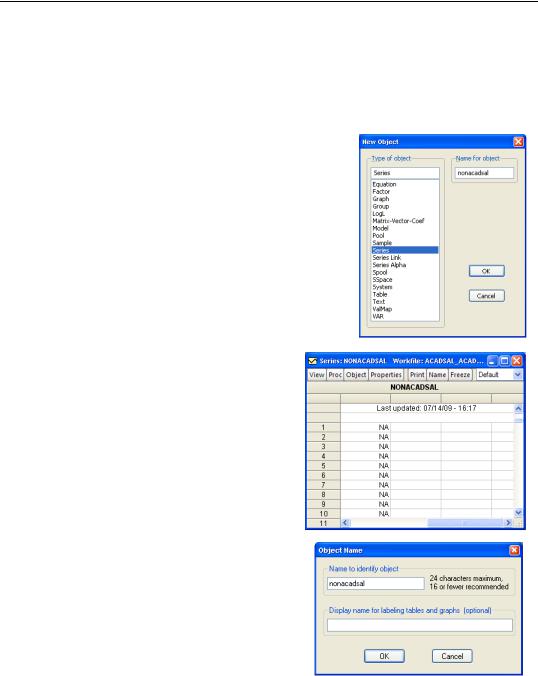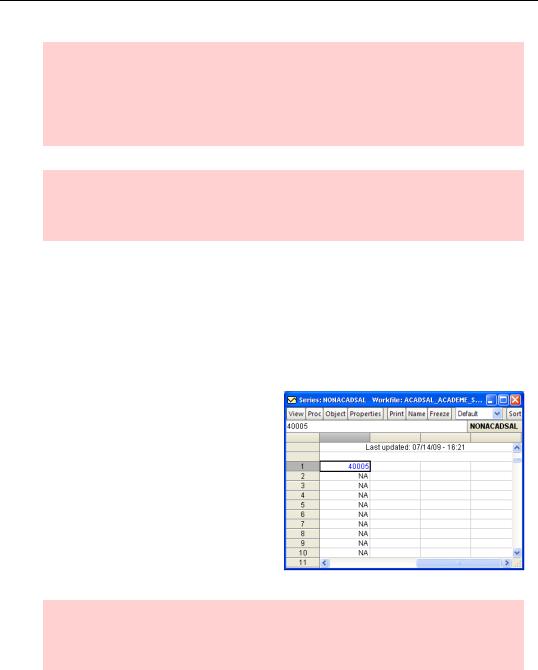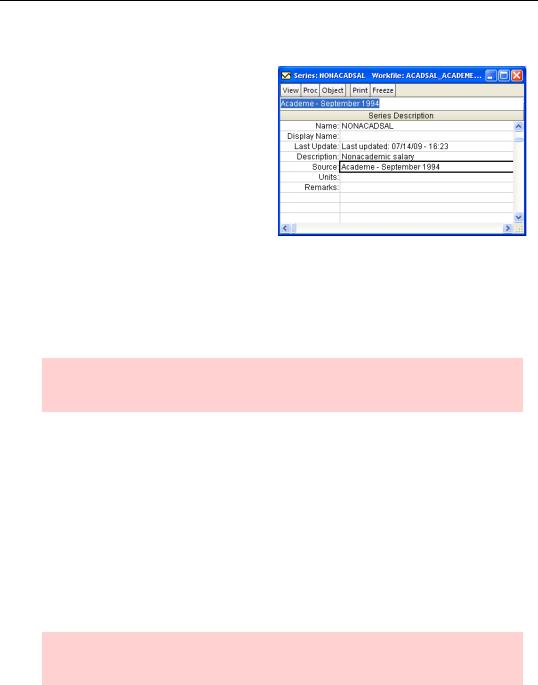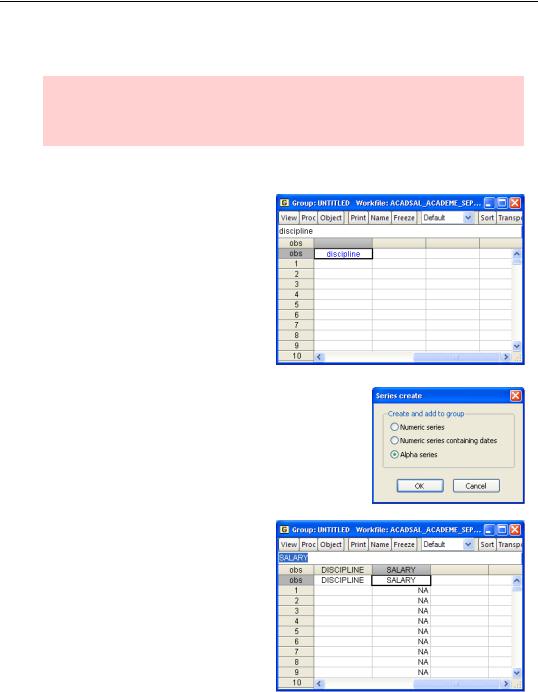
- •Table of Contents
- •Foreword
- •Chapter 1. A Quick Walk Through
- •Workfile: The Basic EViews Document
- •Viewing an individual series
- •Looking at different samples
- •Generating a new series
- •Looking at a pair of series together
- •Estimating your first regression in EViews
- •Saving your work
- •Forecasting
- •What’s Ahead
- •Chapter 2. EViews—Meet Data
- •The Structure of Data and the Structure of a Workfile
- •Creating a New Workfile
- •Deconstructing the Workfile
- •Time to Type
- •Identity Noncrisis
- •Dated Series
- •The Import Business
- •Adding Data To An Existing Workfile—Or, Being Rectangular Doesn’t Mean Being Inflexible
- •Among the Missing
- •Quick Review
- •Appendix: Having A Good Time With Your Date
- •Chapter 3. Getting the Most from Least Squares
- •A First Regression
- •The Really Important Regression Results
- •The Pretty Important (But Not So Important As the Last Section’s) Regression Results
- •A Multiple Regression Is Simple Too
- •Hypothesis Testing
- •Representing
- •What’s Left After You’ve Gotten the Most Out of Least Squares
- •Quick Review
- •Chapter 4. Data—The Transformational Experience
- •Your Basic Elementary Algebra
- •Simple Sample Says
- •Data Types Plain and Fancy
- •Numbers and Letters
- •Can We Have A Date?
- •What Are Your Values?
- •Relative Exotica
- •Quick Review
- •Chapter 5. Picture This!
- •A Simple Soup-To-Nuts Graphing Example
- •A Graphic Description of the Creative Process
- •Picture One Series
- •Group Graphics
- •Let’s Look At This From Another Angle
- •To Summarize
- •Categorical Graphs
- •Togetherness of the Second Sort
- •Quick Review and Look Ahead
- •Chapter 6. Intimacy With Graphic Objects
- •To Freeze Or Not To Freeze Redux
- •A Touch of Text
- •Shady Areas and No-Worry Lines
- •Templates for Success
- •Point Me The Way
- •Your Data Another Sorta Way
- •Give A Graph A Fair Break
- •Options, Options, Options
- •Quick Review?
- •Chapter 7. Look At Your Data
- •Sorting Things Out
- •Describing Series—Just The Facts Please
- •Describing Series—Picturing the Distribution
- •Tests On Series
- •Describing Groups—Just the Facts—Putting It Together
- •Chapter 8. Forecasting
- •Just Push the Forecast Button
- •Theory of Forecasting
- •Dynamic Versus Static Forecasting
- •Sample Forecast Samples
- •Facing the Unknown
- •Forecast Evaluation
- •Forecasting Beneath the Surface
- •Quick Review—Forecasting
- •Chapter 9. Page After Page After Page
- •Pages Are Easy To Reach
- •Creating New Pages
- •Renaming, Deleting, and Saving Pages
- •Multi-Page Workfiles—The Most Basic Motivation
- •Multiple Frequencies—Multiple Pages
- •Links—The Live Connection
- •Unlinking
- •Have A Match?
- •Matching When The Identifiers Are Really Different
- •Contracted Data
- •Expanded Data
- •Having Contractions
- •Two Hints and A GotchYa
- •Quick Review
- •Chapter 10. Prelude to Panel and Pool
- •Pooled or Paneled Population
- •Nuances
- •So What Are the Benefits of Using Pools and Panels?
- •Quick (P)review
- •Chapter 11. Panel—What’s My Line?
- •What’s So Nifty About Panel Data?
- •Setting Up Panel Data
- •Panel Estimation
- •Pretty Panel Pictures
- •More Panel Estimation Techniques
- •One Dimensional Two-Dimensional Panels
- •Fixed Effects With and Without the Social Contrivance of Panel Structure
- •Quick Review—Panel
- •Chapter 12. Everyone Into the Pool
- •Getting Your Feet Wet
- •Playing in the Pool—Data
- •Getting Out of the Pool
- •More Pool Estimation
- •Getting Data In and Out of the Pool
- •Quick Review—Pools
- •Chapter 13. Serial Correlation—Friend or Foe?
- •Visual Checks
- •Testing for Serial Correlation
- •More General Patterns of Serial Correlation
- •Correcting for Serial Correlation
- •Forecasting
- •ARMA and ARIMA Models
- •Quick Review
- •Chapter 14. A Taste of Advanced Estimation
- •Weighted Least Squares
- •Heteroskedasticity
- •Nonlinear Least Squares
- •Generalized Method of Moments
- •Limited Dependent Variables
- •ARCH, etc.
- •Maximum Likelihood—Rolling Your Own
- •System Estimation
- •Vector Autoregressions—VAR
- •Quick Review?
- •Chapter 15. Super Models
- •Your First Homework—Bam, Taken Up A Notch!
- •Looking At Model Solutions
- •More Model Information
- •Your Second Homework
- •Simulating VARs
- •Rich Super Models
- •Quick Review
- •Chapter 16. Get With the Program
- •I Want To Do It Over and Over Again
- •You Want To Have An Argument
- •Program Variables
- •Loopy
- •Other Program Controls
- •A Rolling Example
- •Quick Review
- •Appendix: Sample Programs
- •Chapter 17. Odds and Ends
- •How Much Data Can EViews Handle?
- •How Long Does It Take To Compute An Estimate?
- •Freeze!
- •A Comment On Tables
- •Saving Tables and Almost Tables
- •Saving Graphs and Almost Graphs
- •Unsubtle Redirection
- •Objects and Commands
- •Workfile Backups
- •Updates—A Small Thing
- •Updates—A Big Thing
- •Ready To Take A Break?
- •Help!
- •Odd Ending
- •Chapter 18. Optional Ending
- •Required Options
- •Option-al Recommendations
- •More Detailed Options
- •Window Behavior
- •Font Options
- •Frequency Conversion
- •Alpha Truncation
- •Spreadsheet Defaults
- •Workfile Storage Defaults
- •Estimation Defaults
- •File Locations
- •Graphics Defaults
- •Quick Review
- •Index
- •Symbols

Time to Type—27
Let’s look at the main window area, which is divided into a upper pane holding information about the workfile and a lower pane displaying information about the objects—series, equations, etc.—that are held in the workfile.
Range tells you the identifying numbers or dates of the first and last observation in the workfile—1 and 28 in this example—as well as the count of the number of observations. Sample describes the subset of the observations range being used for current operations. Since all we’ve done so far is to set up a workfile with 28 observations, both Range and Sample are telling us that we have 28 observations. (Later we’ll see how to change the number of observations in the workfile by double-clicking on Range, and how to change the sample by double-clicking on Sample.)
Display Filter is used to control which objects are displayed in the workfile window. Display Filter is useful if you have hundreds of objects: Otherwise it’s safely ignored.
Let’s move to the lower panel. Our brand new workfile comes with two objects preloaded:  and
and  . The series RESID is designated specially to hold the residuals from the last regression, or other statistical estimation. (See Chapter 3, “Getting the Most from Least
. The series RESID is designated specially to hold the residuals from the last regression, or other statistical estimation. (See Chapter 3, “Getting the Most from Least
Squares” for a discussion of residuals.) Since we have not yet run an estimation procedure, the RESID series is empty, i.e., all values are set to NA.
An EViews workfile holds a collection of objects, each kind of object designated by its own icon. Far and away the most important object is the series (icon  ), because that’s where our data are stored. You’ll have noted that the object C has a different icon, a Greek letter b . Instead of a data series, C holds values of coefficients. Right now C is filled with zeros, but if you ran a regression and then double-clicked on C you would find it had been filled with estimated coefficients from the last regression.
), because that’s where our data are stored. You’ll have noted that the object C has a different icon, a Greek letter b . Instead of a data series, C holds values of coefficients. Right now C is filled with zeros, but if you ran a regression and then double-clicked on C you would find it had been filled with estimated coefficients from the last regression.
Time to Type
One Series at a Time
We sit with an empty workfile. How to bring in the data? The easiest way to bring data in is to import data that someone else has already entered into a computer file. But let’s assume that we’re going to type the data in from scratch. Table 1: Academic Salary Data Excerpt displays three variables. You have a choice of entering one variable at a time or entering several in a table format. We’ll illustrate both methods.
Suppose first we’re going to enter one series at a time, starting with NONACADSAL. We want to create a new series and then fill in the appropriate values. The trick is to open a window with an empty series (and then fill it up). There are a bunch of ways to get the desired window to pop open.
These two methods pop open an Untitled series:

28—Chapter 2. EViews—Meet Data
•Type the command “series” in the command pane.
•Use the menu commands Object/New/Series
These two methods create a series named NONACADSAL and place it in the workfile:
•Type the command “series nonacadsal” in the command window.
•Use the menu commands Object/New/Series and then enter NONACADSAL in the Name for object field.
The latter two methods place  in the workfile. Double-click to open a series window. In contrast, the former two methods open a window automatically, but don’t name it. These methods open an untitled series window.
in the workfile. Double-click to open a series window. In contrast, the former two methods open a window automatically, but don’t name it. These methods open an untitled series window.
To name the untitled series, click on the  button and enter NONACADSAL.
button and enter NONACADSAL.
•EViews doesn’t care about capitalization of names. NONACADSAL and nonacadsal are the same thing.

Time to Type—29
Hint: Naming a series (or other object) enters it in the workfile at the same time it attaches a moniker. In contrast, Untitled windows are not kept in the workfile. If you close an Untitled window: Poof! It’s gone. The key to remember is that named objects are saved and that Untitled ones aren’t. This design lets you try out things without cluttering the workfile.
Related hint: You can use the EViews menu item Options/General Options/Windows/Window Behavior to control whether you get a warning before closing an Untitled window. See Chapter 18, “Optional Ending.”
We’re ready to type numbers. But there’s a trick to entering your data. To protect against accidents, EViews locks the window so that it can’t be edited. To unlock, click on the  button. Unlocked windows, as shown below for example, have an edit field just below the button bar. One way to know that a window is locked against editing is to observe the absence of the edit field. Alternatively, if you start typing and nothing happens, you’ll remember that you meant to click on the
button. Unlocked windows, as shown below for example, have an edit field just below the button bar. One way to know that a window is locked against editing is to observe the absence of the edit field. Alternatively, if you start typing and nothing happens, you’ll remember that you meant to click on the  button—at least that’s what usually happens to the author.
button—at least that’s what usually happens to the author.
Initially all the entries in the window are NA, for not available. Click on the cell just to the right of the  and type the first data point for nonacademic salaries, 40005. Hit Enter to complete the entry.
and type the first data point for nonacademic salaries, 40005. Hit Enter to complete the entry.
Enter the rest of the data displayed at the beginning of the chapter. You can use all the usual arrow and tab keys as well as the mouse to move around. In addition, when a cell is selected you can edit its contents in the edit field in the upper left of the window.
Hint for the terminally obedient: For goodness sakes, don’t really enter all the data at the beginning of the chapter. You’ll be bored out of your mind. Just type in a few numbers until you’re comfortable moving around in the window.

30—Chapter 2. EViews—Meet Data
Label View
We know that EViews provides several different views for looking at a series. We enter data in the spreadsheet view and if we need to make a change we can come back to the spreadsheet view to edit existing data. Use the  button to reach the label view where space is provided for you to enter a description, source, etc.
button to reach the label view where space is provided for you to enter a description, source, etc.
EViews automatically fills in the name and date the series was last updated. The other fields are optional. EViews uses the
Display Name for labeling output, so it’s well worth filling out this field. Make the label long enough to be meaningful, but short enough to fit in scarce space on a graph legend. EViews will occasionally make an entry in the Remarks: field. When you start making transformations to a series, a History: field is added with notes on the last ten or so changes.
Hint: It’s worth the trouble to add as much documentation as possible in the series label. Later, you’ll be glad you did.
Typing a Table at a Time
Now let’s turn to entering data in the form of a table. As an example, we’ll enter the name of the academic discipline and the academic salary together. We begin with the same choice— do we name the series before or after we open the window? If you like to name first, do the following:
• Type the following commands in the command window:
series salary
alpha discipline
•Select DISCIPLINE and then SALARY in the workfile window (hold down the Ctrl key to select both series), double-click and choose Open Group to open a group window.
Hint: Series in a group window are displayed from left to right in the same order as you click on them in the workfile window.

Time to Type—31
Note that the series DISCIPLINE is displayed with the  icon to signal a series holding alphabetic data, as contrasted with the
icon to signal a series holding alphabetic data, as contrasted with the  icon for ordinary numeric series.
icon for ordinary numeric series.
Hint: You can name a group and store it in the workfile just as you can with a series. Internally, a group is a list of series names. It’s not a separate copy of the data. A series can be a member of as many different groups as you like.
If you like to open a window before creating a series, do the following:
•Use the menu Quick/Empty Group (Edit Series). When the window opens scroll up one line.
Then type DISCIPLINE in the cell next to the cell marked  .
.
A dialog pops up so that you can tell what sort of series this is going to be.
Since DISCIPLINE is text rather than numbers, choose Alpha series. EViews initializes DISCIPLINE with blank cells.
Move one cell to the right of DISCIPLINE and enter SALARY, this time using the radio button to indicate a numeric series. EViews fills out the series with NAs.
